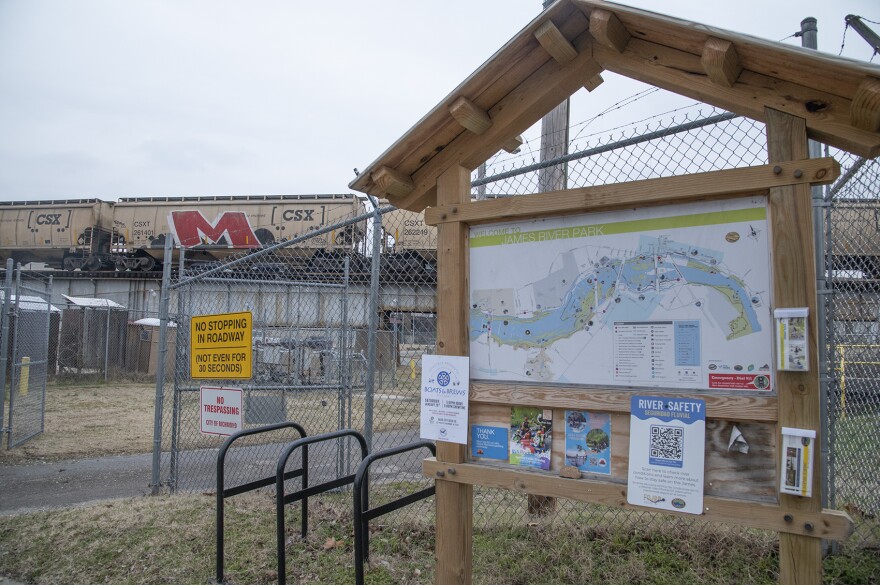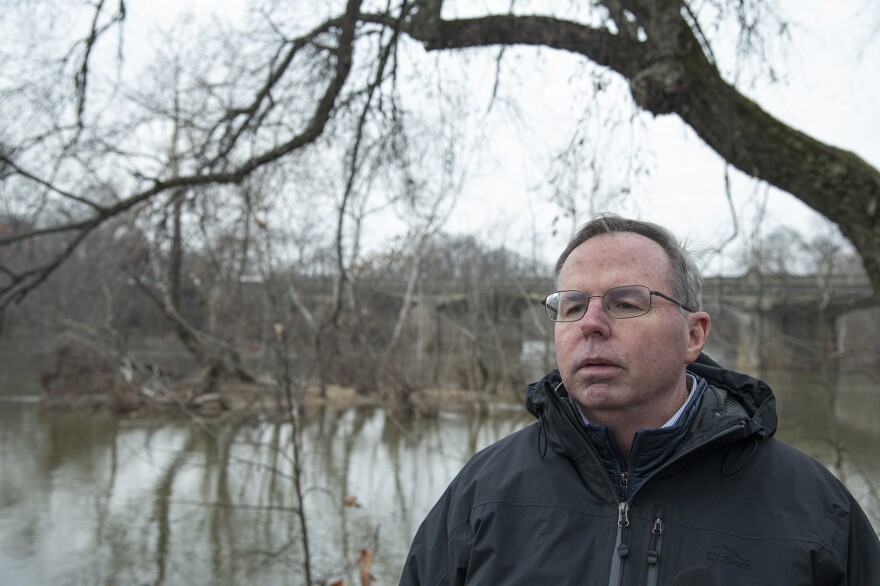Access to the James River is a huge perk of living in Richmond today. But back in the ’90s, Tim Barry said that wasn’t so much the case.
“A lot of people who grew up in Richmond would say to me: ‘I don’t go to the river, it’s dangerous,’” said Barry, who is the singer in the hardcore punk band Avail. He said the James was much more polluted, and there was a bit of an outlaw culture surrounding people who hung out there.
“I grab onto my immediate surroundings. And if I’m spending all my time at the river, it’s going to seep into my songs like it seeps into our lives here,” said Barry, who wrote about pollution going into the river on Avail’s 1998 album, Over the James.
But Barry wasn’t writing specifically about the most well-known pollutant that goes into the James: diluted sewage via Richmond’s combined sewer system.
Pipes that flow into the James, called outfalls, have a dam near the opening. Normally, sewage water doesn’t go over the dam that routes toward the city’s wastewater treatment plant. But during heavy rain, stormwater drains into those pipes, and the mix of about 90% stormwater, approximately 10% other materials spills over the barrier — and into the James. It’s called a combined sewer overflow, or CSO.

“I don't think that that really hit my radar or a lot of people's radar until it became sort of distributed within the park system,” Barry said. “But now I think it's common knowledge — I hope it is — [that] after a heavy rain, probably don't want to go in the river.”
Now, a fraction of pollutants make it into the James River versus when Barry was hanging out at the river decades ago. As of last year, “the amount of CSO entering the James River has been reduced by more than 3 billion gallons annually,” according to a DPU report filed to the Virginia Department of Environmental Quality.
The reduction, which dates back to investments and infrastructure work that began in earnest in the 1970s, represents a capture rate of 91%. But there’s a lot of work left to be done. Richmond needs $1.3 billion to implement major infrastructure upgrades, and the city needs to do it by 2035 to adhere to a deadline the 2020 General Assembly imposed.
If Richmond’s interim plan for reducing overflows is completed by 2027, the capture rate will increase to 92%. But the engineering is challenging and expensive.
“There has been a lot of work ... that has been done in the city of Richmond,” said April Bingham, senior director at the Department of Public Utilities. “But now it's time to really start focusing on ‘How do we pay for it all?’”
If federal and state money don’t make up the shortfall, utility ratepayers in Richmond will have to make up the difference. The annual share of the estimated cost — the $1.3 billion spread over 10 years — represents roughly the same budget as the Richmond Police Department.
“We have a high population here in Richmond of communities that are disadvantaged, people of brown and Black color,” said Bingham. “We want to make sure that we're not pushing a generational funding crisis on to them for generations to come.”
One 12-square mile water watershed and a specific outfall represent the most expensive undertakings.

Richmond's system shows its age
On an overcast day, DPU Engineering Manager Robert Stone took VPM News on a tour of Richmond’s combined sewer system infrastructure.
“This is the Shockoe CSO outfall, it’s the largest outfall in our system,” he over the click-clack of a nearby freight train crossing a James River bridge. Stone says that train is indicative of the challenges of the work.
“We got to work next to railroad tracks, next to interstate highway bridges, in congested Downtown. A lot of these sewers are very deep,” he said. “To try and separate all this sewer in Downtown would just be prohibitively expensive and disruptive to the community.”
The Shockoe outfall makes up more than 80% of Richmond’s annual CSO overflow volume, Stone said.
In 2022, a drier year than usual, more than 480 million gallons of combined water and sewage came through this pipe and flowed into the James. According to Stone this sort of engineering solution — combining sewer and stormwater — was state of the art at the time.
Of course, at the time was the post–Civil War period in the 1870s.
“What they used to say was ‘dilution is the solution to pollution,’” said Grace LeRose, a DPU policy adviser.
LeRose says these days, there are four major solutions or strategies.
One is storage, similar to one of the biggest pieces of infrastructure in Richmond: the Shockoe Retention Basin. Located in the James’ floodplain, heavy metal doors seal to protect the basin, and the three people working shifts there, from flooding. The Shockoe Overflow Basin can hold 50 million gallons. The large facility though is small compared to Mother Nature.
“In an intense summer thunderstorm, this basin can fill up in somewhere between 15 to 30 minutes,” said Stone.

On the cooler day VPM News visited the basin, there’s not too strong of an odor, although there is about 4 feet of water. Although as the tour goes further into the basin, which is the size of three football fields, there is more of a smell.
“You have to know where your rain is falling, and do you have storage?” said LeRose. “If it falls on the South Side, what do you need to do? And if it falls on the North Side, what do you need to do? And if it falls on both sides, what do you need to do?”
The millions of gallons in the Shockoe basin are captured and stored until they can be gradually sent to the wastewater treatment plant during drier weather.
Larger storm pipes are another solution. A bigger pipe acts kind of like storage – a 3-foot pipe holds more water than the 8-inch pipes that are present in a lot of the South Side.
More treatment capacity is another strategy, said LeRose.
“We have one treatment plant in the city. [But] we can do treatment throughout the system,” she said. “We can build a small little plant over on Southside somewhere that treats the water before it goes out to the river.”
Finally, there’s green infrastructure: things like gardens and other permeable surfaces that allow rain to make their way into the ground. If rain is soaking into the ground, that water isn’t contributing to overloading the system.
Parking lots, driveways and streets often divert water into the stormwater system rather than into the ground because they are made with materials that cause precipitation to runoff into storm drains.
This year, Gov. Glenn Youngkin asked the General Assembly to set aside $100 million in the yet-to-be-finalized state budget for these efforts. But legislators aren’t expected to wrap up budget negotiations for at least another month or so. Virginia’s fiscal year ends June 30.
In the meantime, Tim Barry and others will have to be careful about when they decide to take a dip.



